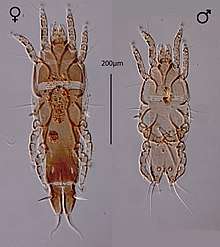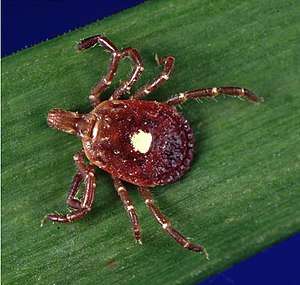Proctophyllodidae
The Proctophyllodidae are a family of the Acarina (mite) order Astigmata. They contain many feather mites. The Alloptidae and Trouessartiidae were in earlier times included here as subfamilies.
| Proctophyllodidae | |
|---|---|
 | |
| Amerodectes zonotrichiae female and male | |
| Scientific classification | |
| Kingdom: | |
| Phylum: | |
| Class: | |
| Subclass: | |
| Order: | |
| (unranked): | |
| Superfamily: | |
| Family: | Proctophyllodidae Trouessart & Mégnin, 1884 |
| Subfamilies | |
| |
Proctophyllodidae females are extremely similar among species and sometimes even hard to assign to a genus, while males vary much more. Two subfamilies are generally recognized, the Proctophyllodinae and the Pterodectinae. The main difference is that the female pregenital apodeme and epimerites IV are separated, while in the latter they are connected and form a distinct structure.
General
Feather mites (subclass Acarina, family Proctophyllodinae) are ectoparasites that live in between the barbs of feathers and are found on nearly every bird species currently described.[1] It was previously believed that these mites had a parasitic relationship with their hosts but it is now thought that most species are more commensal with their hosts.[2][3] Morphological studies have provided strong evidence for this with feather mite mouthparts being identified as unstructured for biting on solid material.[4] Instead it is suggested that they feed on oils and fats secreted from the uropygial gland as well as pollen, fungus and dead epidermis tissue that is trapped within it.[5]
Morphology
Feather mites are streamlined; strongly dorsoventrally flattened with short legs and well-developed ambulacra that act as a hold-fast organ.[6] Being of the order Astigmata, they have biting mouhtparts with a very small gnathosoma compared to body size.
Transmission
Morphological constraints suggest that adult mites are nearly immobile. Transmission of mites has been shown to occur largely between direct interactions between parents and offspring and possibly during gregarious interactions between flock individuals.[3][5] Observations of restricted species contamination on Falconiformes have supported this observation. Birds of prey have the greatest chance of cross contamination through interactions with their prey and yet have very stable acarofauna groups are found exclusively on those species.[6] The European cuckoo, a brood parasite, has also been found to have their own species of mite even though the parents and offspring never interact (but see Lindholm et al., 1998[7])
Selected genera
|
Proctophyllodinae
|
Pterodectinae
|
References
- Heather Proctor & Ian Owens (2000). "Mites and birds: diversity, parasitism and coevolution". Trends in Ecology & Evolution. 15 (9): 358–364. doi:10.1016/S0169-5347(00)01924-8. PMID 10931667.
- Guillermo Blanco; José L. Tella; Jaime Potti; Arturo Baz (2001). "Feather mites on birds: costs of parasitism or conditional outcomes?". Journal of Avian Biology. 32 (3): 271–274. doi:10.1111/j.0908-8857.2001.320310.x. hdl:10261/57455.
- Péter László Pap, Jácint Tökölyi & Tibor Szép (2005). "Host–symbiont relationship and abundance of feather mites in relation to age and body condition of the barn swallow (Hirundo rustica): an experimental study". Canadian Journal of Zoology. 83 (8): 1059–1066. doi:10.1139/z05-100.
- G. W. Krantz, ed. (1971). Manual of Acarology. Oregon State University Press.
- Heather Proctor (2003). "Feather mites (Acari: Astigmata): ecology, behavior and evolution". Annual Review of Entomology. 48: 185–209. doi:10.1146/annurev.ento.48.091801.112725. PMID 12208818.
- Jacek Dabert & Serge V. Mironov (1999). "Origin and evolution of feather mites (Astigmata)". Experimental and Applied Acarology. 23 (6): 437–454. doi:10.1023/A:1006180705101.
- Anna K. Lindholm, Gert J. Venter & Edward A. Ueckermann (1998). "Persistence of passerine ectoparasites on the diederik cuckoo Chrysococcyx caprius". Journal of Zoology. 244 (1): 145–153. doi:10.1111/j.1469-7998.1998.tb00016.x.
Further reading
- Tracy A. Heath, Shannon M. Hedtke & David M. Hillis (2008). "Taxon sampling and the accuracy of phylogenetic analyses". Journal of Systematics and Evolution. 46 (3): 239–257. doi:10.3724/SP.J.1002.2008.08016 (inactive 2020-05-22).
- Michael S. Rosenberg & Sudhir Kumar (2001). "Incomplete taxon sampling is not a problem for phylogenetic inference". Proceedings of the National Academy of Sciences. 98 (19): 10751–10756. Bibcode:2001PNAS...9810751R. doi:10.1073/pnas.191248498. PMC 58547. PMID 11526218.
- Fredrik Ronquist (1998). "Phylogenetic approaches in coevolution and biogeography". Zoologica Scripta. 26 (4): 313–322. doi:10.1111/j.1463-6409.1997.tb00421.x.
- Jacek Dabert, Miroslawa Dabert & Serge V. Mironov (2001). "Phylogeny of feather mite subfamily Avenzoariinae (Acari: Analgoidea: Avenzoariidae) inferred from combined analysis of molecular and morphological data". Molecular Phylogenetics and Evolution. 20 (1): 124–135. doi:10.1006/mpev.2001.0948. PMID 11421653.
